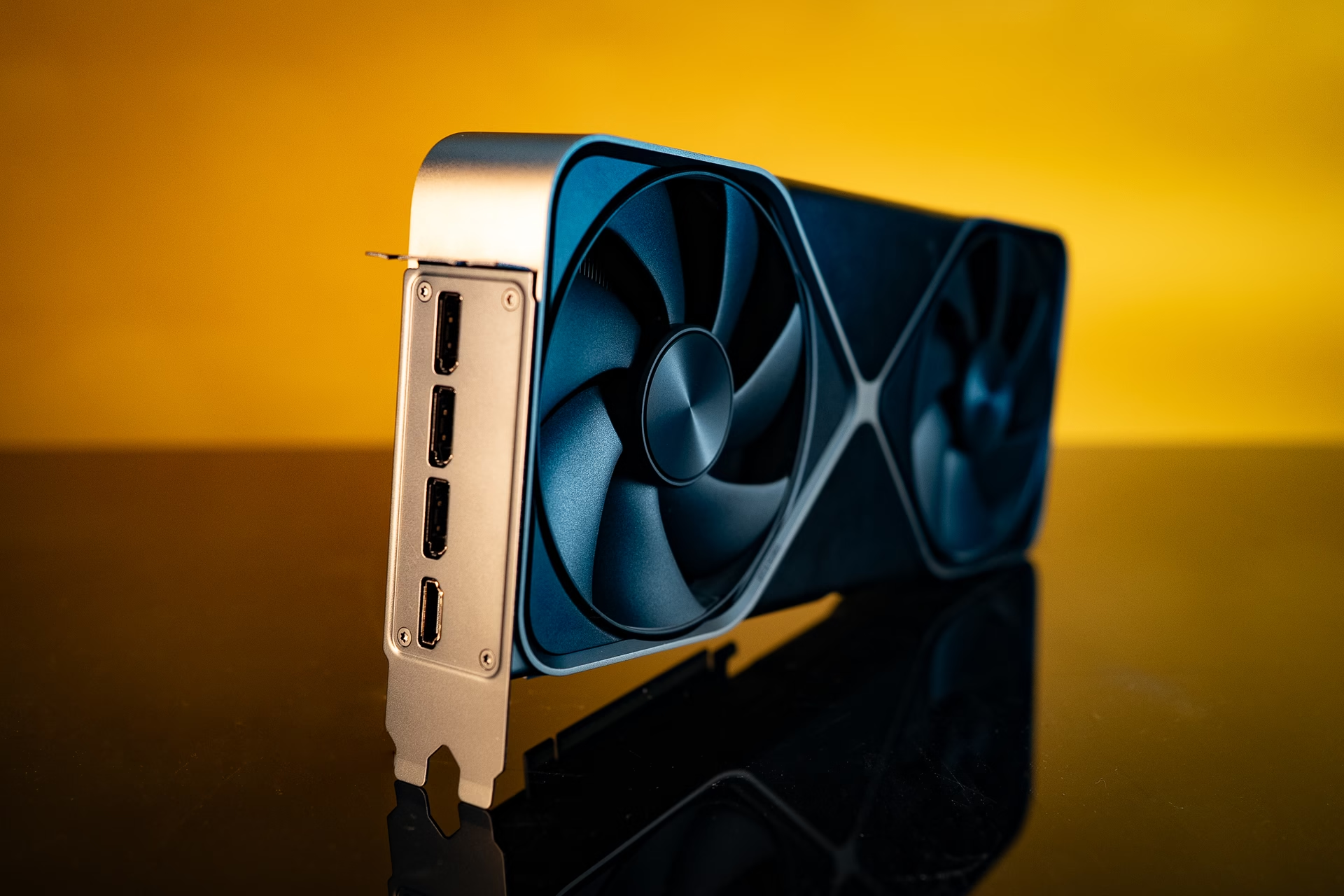Like many of you, I had my hopes pinned on the RTX 50 series being incredible. Again, like many of you, I watched launch-day reviews of the 5080 and wondered if perhaps I should push my aging RTX 3080 along for another year or two. More AI slop, a measly 8% uplift over previous-gen, higher power-draw, 16 GB VRAM, and at the same MRP as the 4080 Super? This was shaping up to be another disappointing year for gaming. Perhaps AMD could achieve the impossible and pull a proverbial rabbit out of its hat by making tangible progress on the RT front? Oh well, stoic-face it is. (Or so I thought).
Being a tech journalist has its perks and it didn’t take much prodding to get Nvidia to send over an RTX 5080 (and an RTX 5090, but we’ll talk about that some other time). My expectations weren’t high to begin with, but the last thing I expected was that I’d be spending two weeks with something akin to an orangutan’s toothy grin plastered on my face as I explored the underbelly of Cyberpunk 2077‘s Night City (at 4K at 200+ FPS) and the dark and twisted world emanating from Alan Wake’s mind.
After years spent fiddling with game settings and watching lengthy optimisation guides in an effort to find that elusive quality vs. performance sweet spot, I can’t tell you how much of a relief it was to be gaming on a card where I could just crank all sliders to 11 and not give a damn.
I’ve watched all the reviews you have and I fully appreciate where the disdain for this launch is coming from. Those reviews aren’t wrong but I’m only here to tell you that seeing (playing?) is believing and that I think the Rs 1,00,000+ you’ll be spending on an RTX 5080 is well worth it.
This is a beast of a card and I’m now convinced that what I thought was AI slop is the true future of gaming. There are issues, most notably pricing and availability, but my hope is that these will be resolved over the coming months. Prices are ridiculous, but they’re slowly dropping.
The RTX 40 and RTX 50 series launches were similar
The RTX 40 series debuted with much the same promise as the RTX 50 series. Nvidia promised 2x the performance of the 30 series thanks to frame-generation technology, introduced an updated AI upscaler (DLSS 3.0 and later 3.5), and debuted Nvidia Reflex — a set of technologies designed primarily to mitigate the input lag issues that frame-generation caused.
Head here for a deeper dive into the new features in the RTX 50 series, suffice it say that the new cards essentially introduce version 2.0 of the features that debuted with RTX 40. These include MFG (multi-frame gen) and a promised 2x performance bump over the RTX 40 series (with 4x MFG), DLSS 4 (a vastly improved upscaler), and Reflex 2 with Frame Warp tech that further reduces perceived latency caused in large part by MFG.
The only difference between the RTX 40 series and RTX 50 series launches is that the tech in the RTX 50 series actually works as advertised. I never bothered upgrading to the RTX 40 series because a) the upgrade was expensive and the performance uplift without frame-gen wasn’t worth it, and b) frame-gen added so much latency that the tech was, again, not worth it, negating any benefit of the 2x uplift.
With the RTX 50 series, I expected the problem to be 2x worse. Twice the frame-gen and twice the latency, right? After playing both Cyberpunk 2077 and Alan Wake 2 at 200+ FPS thanks to MFG and Reflex 2, I now believe that Nvidia has achieved the impossible.
Gaming on a 5080: The subjective experience
The RTX 5080 Founders Edition GPU, which is supposed to retail at Rs 1,10,000 or thereabouts, can only deliver 18.5 FPS in Cyberpunk 2077 at 4K at max settings in RT Overdrive mode without any form of AI upscaling or frame-generation. The 5090, which costs twice as much, can only deliver 30 FPS. It’s a similar story with Alan Wake 2. Without AI, these games are an unplayable, stuttery mess even when using the most expensive GPU on the planet.
Enabling DLSS upscaling allows the 5080 to push 60 FPS in CP2077 and 53 in Alan Wake 2. This is better, but it’s still a laggy experience as FPS dips into the high 30s/low 40s during heavy combat sequences.
Enabling 4x MFG and Reflex 2 pushes average FPS to 185 in CP2077, and 170 in Alan Wake 2. Gameplay is now buttery smooth on my 4K 240 Hz OLED, I cannot perceive any input lag, and I’m finally experiencing the two games as they were meant to be played. The difference in both gameplay and visuals with and without DLSS 4 and MFG is stark. There’s no way I can imagine ever playing these games again without either of these AI-powered features.
If I pixel-peep and force myself to pay close attention to the tiniest of details, yes, I do see the occasional artifact — usually around translucent objects — and can perceive a slight delay in input lag in demanding sequences. However, there’s more jank in the game engine itself than what is introduced by MFG or DLSS 4. If I have to choose between inconsequential visual artifacts and a barely perceivable spike in input latency vs playing at 60 FPS with more severe lag spikes, gaming with MFG enabled is hands-down a better experience.
DLSS 4 and MFG are great… when they’re supported
Here’s the real issue: DLSS4 and MFG are the game-changing features that Nvidia claims they are, but, and this is a big but, the reason I’m spending so much time talking about CP2077 and Alan Wake 2 is that these are the only games that I’ve played that benefit significantly from these features.
Nvidia has published a list of 75 games that support DLSS 4 and MFG at launch. Of those, only a handful are of any interest to me, and I suspect, to you. From the list, I know for a fact that Indiana Jones and the Great Circle, S.T.A.L.K.E.R. 2, and Microsoft Flight Simulator 2024 do not support either DLSS 4 or MFG. Of the games in which I’m interested, Ground Branch and Ready or Not already run at 100+ FPS on a 3080, and Hogwarts Legacy is very well-optimised and doesn’t need MFG as it runs at 100+ FPS anyway.
Do you really want to spend Rs 1,00,000+ on a GPU so you can play two, perhaps three games at 200 FPS? I think not, and until that list of supported games expands meaningfully, I can’t recommend the RTX 5080 outright.
Benchmarks and performance
You’ll find the raw data here but it’s nothing you haven’t already seen in launch-day reviews. The rest of the benchmarks indicate impressive performance, but as others have also pointed out, the card is not meaningfully faster than the RTX 4080 Super when not using MFG.
Focusing exclusively on 4K gaming, Counter-Strike 2 runs at 280+ FPS, F1 23 at 70 FPS without DLSS, and Assetto Corsa Competicizione manages 150 FPS.
Microsoft Flight Simulator delivers 86 FPS with in DLSS Quality mode, Hogwarts Legacy pushes past 110 FPS, S.T.A.L.K.E.R. 2 maintains a steady 70, but Indiana Jones struggles to get past 40.
To get a playable frame-rate in Indiana Jones, you’ll need to drop to DLSS Performance, which only gets you to 53 FPS. While this game supports frame-generation, this is DLSS 3.0 frame-gen and the game suffers from severe input lag.
A note on power draw: Nvidia recommends an 850W PSU for the 5080 FE and the use of three 8-pin PCIe connectors into a single 12VHPWR connector. Average power draw across all the games I tested was only about 300W, 60 short of the 360W TGP the card is rated at. I did see momentary spikes approaching 400W, though, so I’d advise pairing a high-quality PSU with this card. And yes, the 12VHPWR connector is in the news for all the wrong reasons at the moment and I’m only hoping that the 5080’s relatively low power draw (compared to the 5090) means that the connector won’t melt.
Recommendations
The RTX 50 generation is defined by DLSS 4 and MFG, both game-changers, but it’s only when enough games that you care about support these features that you’ll see a meaningful upgrade to your gaming experience, especially if you’re coming from an RTX 40 series card.
Even if you are in the market for a GPU upgrade right now, I’d advise you to wait a bit. The RTX 5080 is a beast, but prices for the GPU are currently hovering around the Rs 1,50,000 mark (40K above MSRP), DLSS 4 and MFG have limited support, and the RTX 5070 Ti (and AMD’s 9070XT) is just around the corner.
For my part, I’m buying an RTX 5080 the moment prices drop, but largely because I’m coming from an RTX 3080 and can’t imagine going back to either Cyberpunk 2077 or Alan Wake 2 and playing at 30-40 FPS. Plus, GTA VI and Doom: The Dark Ages are expected this year. I likely have more money than sense considering there’s no way I’m playing those games at anything short of 200 FPS.
Disclosure: Nvidia and AMD provided the hardware that made this review possible. However, neither party was involved in the testing and review process, and neither party was informed of the contents of this review before it was published.


